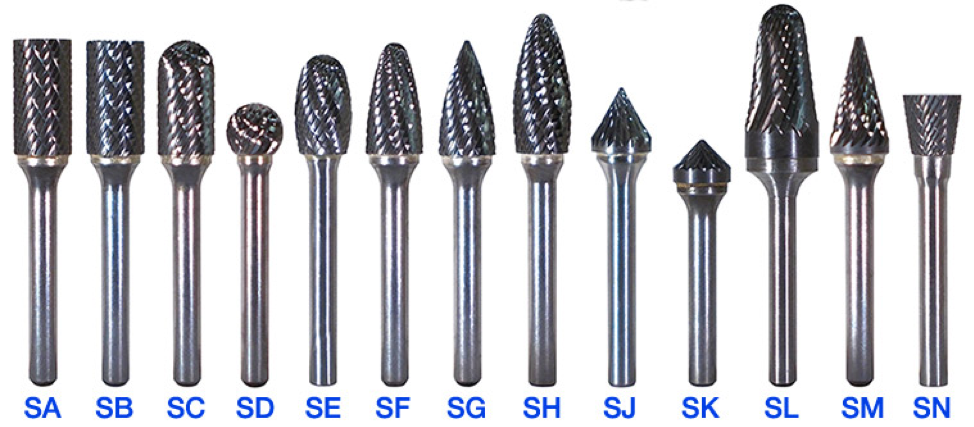1. MANY MATERIALS CAN BE USED WITH CARBIDE BURRS
All types of wood, plastics such as glass fiber reinforced plastic (GRP), carbon fibre reinforced plastic (CRP), fiberglass, acrylic, and metals including certain, aluminum, and steel are among the materials which use tungsten carbide burrs. Carbide burrs have a long lifespan acquiring to break or shattering, causing them to be appropriate for soft metals like silver, platinum, and gold. Titanium, nickel, cobalt, zinc, and also other metals are probably the others.

WHAT APPLICATIONS ARE CARBIDE BURRS Employed in?
Die grinders, high-speed engravers, and pneumatic rotary tools are instances of air tools that often employ carbide burrs. Other examples are hobby rotary tools, flexible shafts, pendant drills, and micro motors. Remember to make use of a handpiece that does not wobble all the time.
THE Reason for CARBIDE BURRS
Carbide burrs are widely-used in several fields, including metalworking, dentistry, the auto, and aerospace sectors, amongst others. These are frequently used in several industries for metalwork such as carving, cylinder head porting, grinding, deburring, casting, chamfering, welding, jewelry making, wood carving, model engineering, and tool building.
2. CARBIDE BURR CUT TYPES: SINGLE CUT AND DOUBLE/DIAMOND CUT
Single-cut carbide burrs, often called one flute, will efficiently remove the material having a smooth finish if in combination with right-handed spiral flutes. They mostly assist stainless, iron, hardened steel, and ferrous metals like copper and iron. These are right for heavy stock removal, milling, and deburring.
Alternatively, the double-cut carbide burrs, often known as cross-cut or diamond-cut due to the two flutes which are cut across one another, are usually suited for all non-metal materials, including soft steel, aluminum, wood, and ferrous and non-ferrous metals. The tip is smoother with the double-cut carbide burrs compared to the only cut because they make smaller chips once they remove the material.
3. SHAPES OF CARBIDE BURRS
The cut or profile you want to accomplish will guide your selection about the type of carbide burr to utilize. The various shapes of carbide burrs are highlighted below:
Carbide Ball Burrs
Carbide Inverted Cone Burrs
Carbide Tree Burrs
Carbide Pointed Cone & Ball Nose Burrs; Carbide Round Nose Burrs
Oval Burrs
Cylinder Burrs. End/Ball nose/ Round Nose Cut
Flame Burrs
Countersink Burrs
Oblate Spheroid
4. LIMIT The quantity of PRESSURE YOU USE
As with most drill bits and burrs, allow burr perform work and exert gentle pressure; otherwise, the flutes’ cutting edges will chip off or lessen too rapidly, shortening the burr’s lifespan.
5. How rapid (RPM) In the event you OPERATE THE CARBIDE BURRS?
The velocity at which you employ your carbide burr occur your rotary tool depends on the design being formed and also the material to get handled. However, you need to start slowly and get speed because you proceed. Speeds over 35,000 RPM are unacceptable.
6. In comparison with HSS BURRS, CARBIDE BURRS ARE STIFFER
Burrs created from high-quality carbides are produced by machine. As Tungsten Carbide is extremely dense (compared to HSS), it can be well suited for a lot more difficult projects than HSS. Carbide burrs are also more heat resistant than HSS, for them to run hotter longer.
For long-term performance, a carbide is obviously a preferable option because HSS burrs are going to weaken at higher temperatures.
7. CONTINUOUSLY MOVE THE CARBIDE BURR
Never hold your die grinder bit stationary for days on end when utilizing it. This can stay away from the burr from poking and burrowing to the material, leaving ugly markings and roughness. To provide work a nicer finish, end by having an “up” stroke. Soft iron can easily be unclogged using a carbide burr.
For more info about die grinder bits for hard steel check out this useful site
